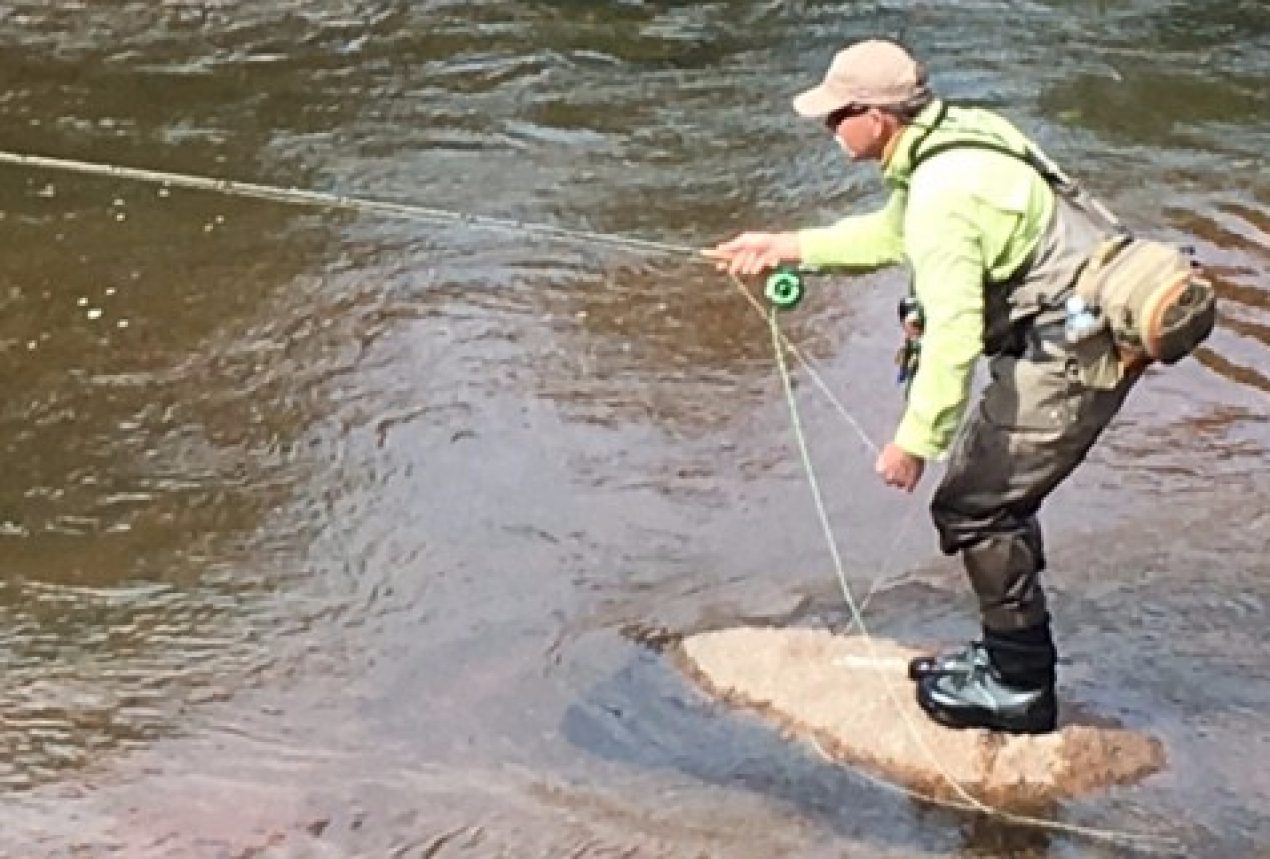It was a loooong season culminating with less than stellar fishing. After the long, record-breaking snow season we had last year, I’m ready for a normal winter. Record high flows that birthed flood stage conditions on many of the state’s rivers, including the Eagle River near Vail, Colorado, gave way to a longer than average summer dry-spell, that had me, the fish, and the insect life confused. Water temperatures and clarity never really was consistent. The only constant was one had to outwork the fish with persistence and a bit of ingenuity.
The last recorded snow in Minturn Colorado, where our fly shop is, was June 22nd. Big ole flapjack flakes sizzling as they contacted the already higher than normal flows, forced me to get out of my comfort zone. Several years of note taking was rendered useless, because there wasn’t really anything I could compare it to. Bigger than normal flows, coupled with lower than normal temperatures, seemed as if it put things back at least three weeks. Using April tactics in May or worse yet, June tactics in July, had my head reeling. I learned a lot though, probably more than the last ten years combined.
I’ll put it this way; I was using dry-dropper rigs, the mini rig specifically, well into November this year. Typically, November is for long and lean indicator fishing, but not this year. Because of the gin clear water along the entire main stem, the late caddis hatch, low flows, and an extended pseudo baetis hatch, the best way to move fish was under a big Chubby Chernobyl or Fuzzy Wuzzy with two weight free droppers below. A size twenty Butt Crack Baetis below a size sixteen autumn orange DP643 soft-hackle, saved many a day for me this fall. Heck, fish were still coming up occasionally for the big dry in November!
So, November fished like a poor October, and October fished like a less than average September. This led to September fishing like angry August, where feeding fish and insects were hard to come by. July had incredible high flows which pushed the fish to the edges. That was the good news; the bad news is that forced all of the anglers to hit the same inside edges. More water flowing down the river, when it’s this high, means fewer places for a wade guide to fish. Lord knows we couldn’t cross safely, so we were all stuck to the same runs. Boats could float the middle, but you guessed it, they also fished those same soft edge seams. If they weren’t fishing in the soft seams, many of them anchored in them to tend to their business.
Two days in October were firsts for me. Once, on a full day guide trip with two anglers, we sat down for lunch with only one fish to show for our efforts. About a week later, I sat for lunch with one client and we had zero fish to show for our efforts! Thankfully, in both cases, we out-worked the river and ended up having fine days. But dang, this was getting old! The afternoon feeding windows finally opened and, using the exact same rigs and flies, the fish decided to play along. Just goes to show, Mother Nature always has the final say. She determines everything from feeding windows to hatches. Gotta admit, I cursed her a bit more than usual….
So, that was my season. I kept copious notes outlining every guide trip and fishing trip I embarked on. Those notes may make for a good book in the future….wink wink.
Switching gears here, you all know how I like to try out new gadgets and gizmo’s folks send to me. This year, I was lucky enough to be able to get my hands on a new type of indicator (https://ghostechsi.com/). This is a neat little indicator that combines many favorable characteristics of other indicators into a new design.
I ran this indicator in low clear water and high fast murky water with clients and gathered their feedback over the months. The feedback was favorable, and we caught plenty of fish under them. Some of the positive feedback revolved around how lightly the indicator fell upon the water, how sensitive it is to anything that happens sub surface, and how quickly it can be adjusted. I found all of those thoughts to be accurate.
My first set were all white in color and clients admitted to having tough times picking them out in foam lines, but the newer versions are white, yellow, or fluorescent orange. I began using a combination of the white and fluorescent, and visibility became much better as relayed by my clients.
No one system is perfect, and I do have to relay one thing that I found to be a negative. There’s a small plastic nut that goes onto a stem that holds the “floating plates” together as it attaches to the leader. There were times, with cold fingers, that I couldn’t get that nut tight enough to stay in one place on the leader. Could be just me, but the indicator did slide down the line quite often in those conditions.
When you look at the pictures, you’ll see the little “floating plates”, ingenious idea really, and each one of those adds additional floatation to your rig. I found I could load up the weight in heavy/fast water, and the indicator still performed well using three of those plates at a time. For beginners, the indicator was more difficult to cast because it didn’t have they weight they were accustomed to from the big plastic bobbers we often use. But with some work, they usually overcame that issue by fine-tuning casting methods and techniques. Final analysis- they’re worth a try, you may just adopt it as your preferred method.
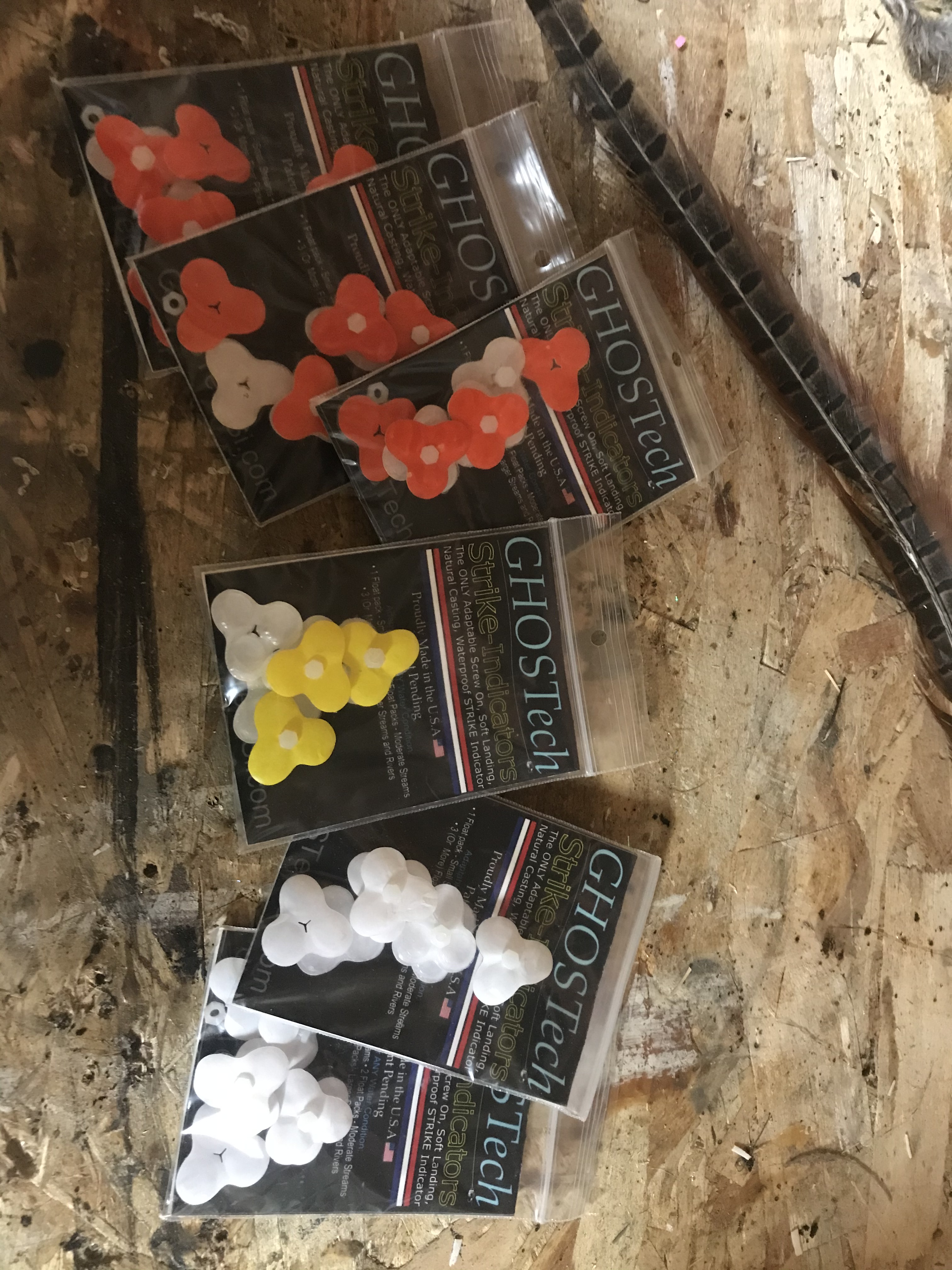
So, I moved to Grand Junction, CO last June. Love it on the western slope. Great weather, slower paced, new water nearby. Still guiding on the Eagle River out of Minturn, but loving finding new local water to explore. I found one little creek that I fished my way up into about a half mile. Many eager fish, all on the euro rig, but not another soul. I didn’t even see another human footprint. Found a ton of deer tracks….but that’s a story for later ; ^ )
My fly fishing style has changed over the last few years as I have gone to exclusively European style fishing. I still put my clients under an indicator or big dry most often, but when I fish I enjoy the technical simplicity. I run the 10′-6″- 3wt Bellator rod from Master Nymph and really, it is the best rod I own. I really enjoy putting it in the hands of my clients and watch them catch their first fish without an indicator sub-surface. I am going to work on a few things this winter as I try to get better at this method, like long line work and fishing with it in the wind. I have developed my own method with leaders and fly combos that I call “eurorado nymphing”. It works and has rejuvenated my fly fishing and guiding.
The #buttcrackbaetis has continued to be my most productive fly in all seasons. I enjoy tying and fishing that fly. This time of year, that fly in a purple bodied size 20 can be smokin’ hot. I have a tying demo up on youtube if you’re interested: https://www.youtube.com/watch?v=EkB4RcQP4NM
Montana Fly Company was gracious enough to select another of my patterns. The DP643 has been in my fly box and rigs for about 4 years now, but it wasn’t til last year that I felt the pattern had been perfected and was ready for the big world. DP- stands for double play, 643 stands for short-to second- to first. I know, lame baseball reference, but I couldn’t help myself. It’s in the Montana Fly Co catalog, or check-in with your local fly shop if you’re interested. I may put out a DP643 tying demo on YT later this year.

I am cutting back on my travel this year. Although I really enjoy speaking (did about 30 gigs a year the last 4 or so years), I’d like to spend more time writing, tying, and fishing. I am in Phoenix the 11 and 12th of December (really looking forward to this), Denver Flay Fishing Show, International Sportsmen’s Expo, and Edison FFS all in January. After that barrage I’ve about four or so more til early April. It feels odd to turn down offers because I worked so hard to build up that gig, but at this point it’s time to slow down a bit. I’m on the Western Slope for Heaven’s sake…..
The books are doing well, and still make great gifts for the holidays. I spent this entire past year doing research for the next book. Holy smokes I have a tone of stuff to organize……

Happy Thanksgiving, and thanks for checking in.
Fear No Water
Feel Your Way…….
Hidy Ho Good Neighbors,
So, have you tried Euro style nymphing yet? I know, sounds funny coming from a guy that wrote a book about the systematic approach to nymphing, but I have done a fair amount of this technique over the last couple of years. Even have my clients working a modified euro system on pretty much every guide trip.
Now, I’m no expert on euro style, but I appear to be qualified enough to talk about it because my clients catch plenty of fish, even on the first time out, using my quirky method. I tagged my method “eurorado nymphing” because it includes Colorado nymphing methods coupled with euro-style principles. I’ve included a section in my latest book, Hidden in Plain View, that goes into greater depth on what I do.

A good stocking stuffer
Suspended nymphing under an indicator still has a place in my arsenal as it can create longer more consistent drifts, gives you the ability to work water that is more than a couple rod lengths away, and gives you the ability to see fish eats thru the indicator. However, the ability to work the upper half of a drift effectively while dialing in drift speeds is a bit tougher under an indicator. Think back to the last time you nymph fished, how many fish did you catch upstream of the halfway point of your drift? Exactly, it’s hard to recall because it just doesn’t happen as often as the fish you catch from the middle to end of the nymph drift. That’s because that is when most anglers have the depth and speed finally perfect.
Eurorado style, on the other hand, allows you to work the upper part of the drift well. It allows you to feel working over obstructions, shelves and bars. And, you catch the majority of the fish above the middle point of your drift, because you get the bugs down quickly, and dial in depth and speed quickly after your bugs hit the water. Each method has its merits, but like I always say, the more versatile an angler you are, the more you’ll enjoy the sport.
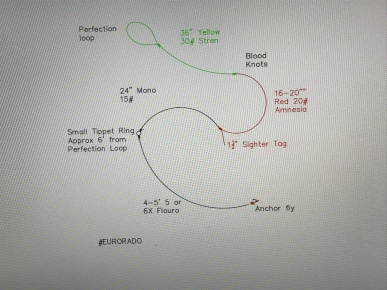
Customize as needed
Some days Eurorado nymphing is like a vacuum, picking up fish in a river where suspended nymphing wouldn’t be able to and it’s relatively easy to rig and learn. Again, I’m no expert, but there are many videos available that can get you started. As for gear, I run a 10’6” 3 weight Master Nymph Bellator fly rod with a matching Lamson Liquid reel. This rig is balanced and light weight with incredible accuracy and fish fighting capabilities. I also employ a sighter-leader of my design and use bugs of my design.

A gaggle of Booby Traps
The sighter-leader and flies used is where I put the “rado” in this rig, because it smacks of Colorado nymphing. Most Euro-style leaders are around twenty feet (and longer) lengths, whereas my leader is around eleven feet long. It is comprised of several different sections of monofilament, fluorocarbon, and amnesia lines, with a sighter tag and tippet ring thrown in for a cause (see pic). As for my bugs, I run a weighted Booby Trap, as my anchor, and run in-line off of that. So, off the bend of the Booby Trap, I run tippet to a DP643 which is an unweighted soft hackle, and off of that bend I run a Butt Crack Baetis (unweighted) in the appropriate size and color. I’m sure you can see the indicator nymphing influence here.
This rig has served me and my clients well over the last couple of years on the Eagle River, and it can easily be customized to your favorite water with a little thought and tinkering. I continue to learn a bit more each time my boots get wet, but I am sold on this technique. I really enjoy the simplicity, ability to feel your way along a river bottom, and the consistency to get depths and speeds dialed in quickly on every drift.
That’s my story and I’m sticking to it…….Fear No Water!
Happy Holidays!
Hidy Ho Good Neighbors,
I pulled on the zipper for the last time as the fabric separated from the zipper and the zipper slide became lodged on the teeth. This is quite disconcerting as you’re knee deep in the river with no way to ensure your fly boxes aren’t going to become refugees. I hadn’t put more than one hundred guide trips on the waist pack I had and it was not showing the durability of previous gear from this manufacturer. Right then and there I decided to look into a different company to supply me another waist pack.
I’ve dealt with Umpqua gear in the past and was always satisfied with their performance and durability. My Tongass pack has never let me down as I have traveled the country with it, floated down several rivers, and even went for a few unplanned dips in the water with it on my back. Each instance, the pack has answered the durability bell and kept my expensive camera gear bone dry. I chose the Umpqua Ledges 650 waist pack in hopes that it would perform equally as well.
I just completed my sixtieth guide trip with the new pack and I like it very much. Every piece of gear in my old waist pack fit nicely in the Ledges 650 and left space for more gear than I typically carry. The large compartment has a leaf installed that helps keep your boxes separate and organized. Boxes slide in and out without issue. The pack is very comfortable to wear as the wide hip belt and shoulder straps are well padded and ergonomically justified. I especially like the plastic plate between where your hip and the bag meet. This allows the pack to freely slide around your torso without catching your waders and coming to a quick halt. This feature also provides a space between the pack and angler that keeps one from overheating on those hot summer afternoons.
The fabric is very durable, well stitched, and for what it’s worth, I like the color patterns. The zippers, ahh the zippers, my usual nemesis, have worked unerringly. The zippers are incredibly hard core, over-sized, and the pulls are reinforced, dipped, and will take a pretty good tug over and over again. Point blank durability at its finest.
Speaking of zippers, I do have a slight issue with the placement of the main compartment zipper. I have found it difficult at times to open or close that compartment because the zippers are in close proximity to my body and it’s tough to get the zipper started as you open or close the compartment. My opinion is that in the next generation, the designers may want to look at moving that zipper to the front of the bag. It’s not a show-stopper for me; it’s just that everything else with this pack is perfect, why not this too?
There are a couple of sleeper amenities on this pack that are worth their weight in gold. In the front there’s a great slot to carry forceps. I carry two spares in there. Also, under the used fly pad, there’s a neat compartment for whatever where I carry my thermometer, and below that is a zippered pocket where I carry extra leaders and my phone. I really like the compartments on the belt straps; I carry my weights, dry shake, extra lighter, and a fly puck in those. The front elastic pockets are a handy “get-to-fast” feature, and the compartments behind those are hard to overfill with tippet, pucks, or a cigar or two. This pack just has it going on.
Overall, I give this pack a very high rating, and I have only had it a third of a season. I expect it to age gracefully and keep me well supplied and comfortable for its entire life. Thanks Umpqua, for another fine piece of fly fishing gear.
Fear No Water!
Duane
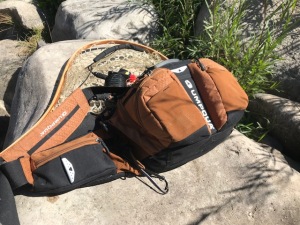
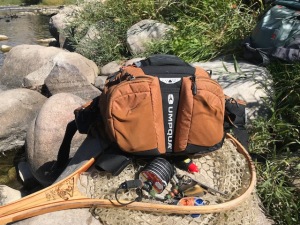
Hidy Ho Good Neighbors,
It was my eleventh summer and a group of my neighborhood buddies and I pooled our resources and engineering prowess to construct a very fine tree fort. This fort had everything, windows that opened and closed, quick exit trap doors, radio antennae, and a rope ladder. We were kings of the tree tops.
Our inaugural sleep-in night was upon us and just after we settled in for the evening someone tossed a lit smoke-bomb into our abode. I remember clicking on my flashlight and being surrounded by stinky blue smoke. We bailed out as quickly as possible, but the night was ruined. All that preparation and anticipation went right down the tubes. We were ticked.
I thought about the smoke-bomb incident the other day as I was standing in a well-known front range tailwater. I spend a lot of time guiding other fly fishers and every so often; I get to hit the river by myself, which is always a treat. I plan, re-rig my fly rods, spin a few special flies, and no matter how tired I am from the weeks work, I’m always up early and anxious to go.
I arrived much earlier than the other anglers, and had settled into a favorite run. This run has room for one angler, is choked with willows on the anglers backcast, and the perimeters can be easily reached with a decent roll cast. In other words, it’s a small section of river that a modest fly caster can cover top to bottom and bank to bank, without moving an inch.
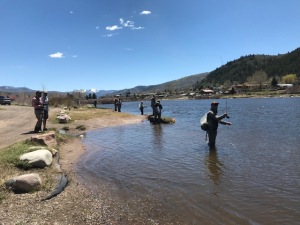
Crowded rivers can lead to poor etiquette, unfortunately.
I had settled in, and put a couple small rainbows and one decent brown trout in the bottom of my net in around fifteen minutes. I smiled to myself after landing the last fish, relaxed a bit, and lit my pipe. Just then, I hear splashing below me in the run as two anglers step into the drink. They both look at me as I angle my head to the side, hitting them with a “What are you going to do?” non-verbal cue. One of the guys stops in his tracks, the other proceeds to place a roll cast into my run while trying to avoid eye-contact. His first cast, had I been in a drift, would have crossed my line!
I turned facing him and uttered, “Really, this is the best you can do?” He didn’t say a word, backed out and took his partner with him. I stood there for a minute shaking my head. I stripped out some line and readied for my next upstream presentation, when all of a sudden, those two knuckleheads bust through the willows on the bank above me, waded in, and began to fish. I could have easily cast over both of their lines. Smoke-bomb in the tree house!
I rigged up my rod and slogged over to the bank. Just before leaving I reminded them that they needed to learn some manners, and mentioned something about trout in public places, and we not only need to respect the fish, but the fishermen as well. They heard me but neither had the courage to make eye contact. I’m still pissed.
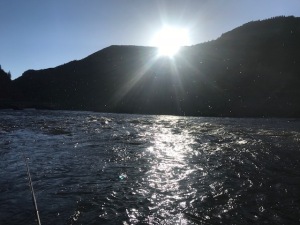
Can’t always be like this, but we can play nicely…..
The majority of anglers know fishing etiquette. Always ask folks which way they plan to fish, upstream or downstream, give them plenty of room, and extend to them the same courtesy you would expect from others. Don’t walk the banks above an angler working a run. That’s a good way to spook fish he is working. Always try to give them the run they’re in and the shelf above it. I’ll often ask if it’s ok to hit the run above them, if it’s a good distance above the shelf that marks the top of their run.
Maybe that’s part of it, folks don’t know how to read the river, which gives them no discernable start and stop places. Maybe they simply need to learn a typical run; riffle, shelf, pool, glide, tailout, riffle. Frankly, I’m not confident that will solve the issue, this comes down to a “me first” mentality. An ”I need this fish picture for my social media”, mentality. Yep, I’m still a little pissed.
I am more than annoyed at what fly fishing has become on our crowded rivers in Colorado. So many anglers, packed into a few miles of rivers. Still, I think with a healthy dose of etiquette, we could have fun days even on highly pressured waters. I have been preaching fishing etiquette for as long as I can remember, and there are days when it’s certainly more than annoying, but we have to keep teaching protocol one angler at a time. Fear No Water!
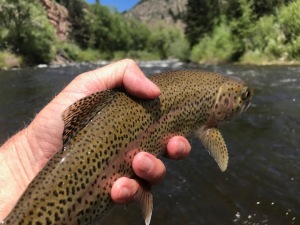
Simply remember the golden rule
Of Redds and Run-off
Every year I hear the same old crap about folks ripping spawning fish off Redds. Drives me crazy, infuriates me really. How can you interrupt something as sacred as spawning fish? That’s our guarantee for future fishing, and there ain’t nothing wrong with wild fish, or the fish helping out in the quest for more fish. Our respective game and fish departments can’t do it all.
Maybe some folks just don’t know what to look for, so here goes: look for water up to about thirty inches deep with areas that looked like they’ve been swept with a broom. Usually, this is a flatter section of the river, with slower moving water. Also, look for one or more fish sitting atop this swept out area. I’ve seen redds the size of a coffee table, up to the size of an auditorium. Both are equally easy to spot if you’re paying attention.
You may be thinking, “So where do I fish then?” The answer is simple, “Not on the redd, but above or below it.” Target the species not spawning on the shelves and pools below spawning fish. Hmmmmm, wonder what patterns to throw…You can certainly toss egg patterns in your nymph rigs and follow that up with the fly of the day, or the dominant hatching insect. No mystery, really, just do your best to be observant, step around the redds, and fish anywhere but on them.
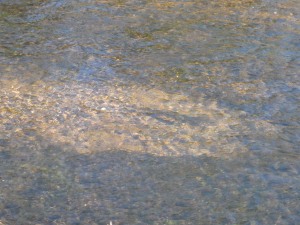
Pretty dang obvious Redd. Just observe.
Run-off is bearing down on us as the water rises and goes off color. My day usually starts out nymphing two and three bug rigs under an indicator, using darker and sparser bugs. I like weighted flies (odd for me, but conditions call for it), with dark and sparse materials, to get the bugs down quickly and allow the fish to readily see them. The darker colors are easier for fish to see in off-color water. I tie my favorite flies in black, purple, red, and even throw in some true fluorescent orange and pink collars to provide for “hot-spots” and visibility.
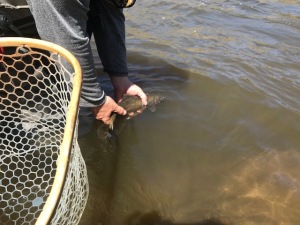
Little dirt in the drink.
Lately, my days have been ending throwing the mini-rig (it’s in the book), with a black Chubby Chernobyl followed by a black soft hackle (DP643), and a size 18 purple Butt Crack Baetis. Killer. The fish are moving to the edges and up into the riffles (not redds) to consume baetis swimmers and emergers, and the occasional skwala stones and migdes. You’ve all heard me preach about carrying two rigged rods, well this time of year is perfect for it. So, mornings I work bottom up, afternoons, top down.
Don’t hesitate to rip streamers as the water’s rising, that can be as productive as it is fun. I like to run tandem rigs with a white or lightly colored streamer up front, followed by a Slumpbuster or similar 20# below on 2 or 3 X tippet. I like to tie a loop knot to the trailing streamer to allow for a bit more movement. Typically, I’ll run a five to six foot tapered leader down to 2 or 3X to my first streamer, tie off the bend with the same to my terminal meat. If you’re not moving fish, you’re probably above their level, so employ more weight, casting angles, or mending techniques to get those streamers deeper. Vary your retrieves, strip set, and hang on.
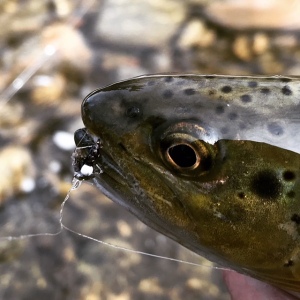
Black soft-hackles during run-off
As we get into full-blown chaos with run-off, focus on the banks, edges, eddy’s, and sleeper seams out from the banks. Just be damn careful stepping into crazy water. Dress appropriately, use a wading staff, take a friend, and show discretion and common sense. It’s not worth dying for.
A few nymphs to consider for run-off:
Black Pat’s Rubberlegs
Black Leeches
Cranefly Larva
Black Soft-Hackles (#16-18)
Purple Butt Crack Baetis (#18)
Purple, Pink or Red San Juan Worm
Various Egg patterns

Purple Butt Crack Baetis
Fear No Water…except during run-off
Hidy Ho Good Neighbors,
I feel like I beat this subject to death, but it’s that important. Heck, it’s critical to fly fishing success. Whether your nymphing, dry-dropping, mini-rigging, skinny rigging, or dry fly fishing, keeping those flies flowing like the naturals in the Y seam to positioned fish is a skill to master.
Think of drinking your latte this morning, your mug went directly to your mug! In other words, you didn’t have to think twice about the path to your mouth, nor did you have to move to collide with the cup. It flowed to your mouth naturally. I contend, that if feeding fish have to move to eat your flies that are drifting unnaturally in the current, they will most often pass yours up to eat the naturals that are flowing perfectly. Fish see thousands of natural bugs drifting in the currents every day, if you can’t match that drift, you’re in for long days.
The Y seam is rarely if ever a straight line, it’s usually drifting to or away from you. Often it’s a combination of both, and fish set-up in advantageous spots, that make feeding on “real” bugs almost effortless. Don’t make them work for a meal. Strive to stay at proper depths and speeds as you stay in the Y seam.
I have uploaded a video for you to watch at: https://youtu.be/Up8EUzO0RxM
As always, find this and more explained in my latest book, Hidden in Plain View (Amazon)
Hit me with questions and comments, share the video with your fishing buddies, and Fear No Water!

Directly to this face! Master the Y seam drift!
Hidy Ho Good Neighbors,
Once again, the speaking circuit is up and running. Just got back from Atlanta, and getting ready to head to Texas for the GRTU Troutfest. In between, I will have a couple chances to get on the water, tie a few bugs, and tighten up my speaking game. It’s a whole different world this time of year.
Buzzing around the country talking with so many anglers is quite humbling and extra enjoyable. I sat with Lincoln Westby (look him up if you don’t know who he is) for two full days last week at the Atlanta show, just picking his brain. At seventy plus years of age he is still incredibly passionate about this sport. I was humbled and truly thankful for that opportunity, plus I picked up more than a few tips. I bump into all kinds of people that teach me loads simply by the questions they ask. Many times, I have to stop and think on their question, which forces me to make ask them questions, make choices, clarify, or quantify a stance on a particular subject. Doing this tends to sharpen ones focus, and steel ones opinions.
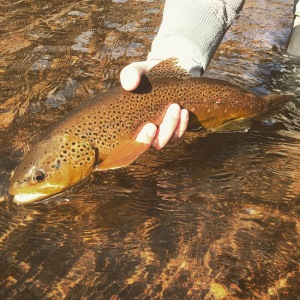
@rodcuffs releasing a South Platte Brownie
Once I begin to sharpen focus on a subject then I begin to dig into my reasoning for believing one way or another, and every now and then, I change my stance on a previously held thought. Sometimes, however, I stop, cock my head to one side and think, “Nope, not going to believe that.”
At a show last year, I was walking by the casting pool as someone was presenting to a group of anglers. This presenter was talking about setting the hook techniques, and had the fly rod pointing down to the opposite end of the pool as the point was made. With line out in the pool, and a large management loop formed from the index finger on the cork, this person proceeded to explain a dry fly set. “Reach up here with your left hand, grab the fly line up here above the cork, and pull hard to the side as fast as possible.” I stopped in mid stride at the edge of the pool just to confirm what I thought I heard. Yup, that’s what I heard.
So, in front of your management loop, you reach up with your off-hand grabbing the fly line and pulling to the side for the set. This alignment renders your loop worthless. What if you happen to hook the fish? Then, you’d have to take the line in your off hand and put it back under your index finger on the cork, just to begin to fight the fish. This is as hard to explain as it is to be believe. So, imagine you’re holding the fly rod in your right hand, and the management loop is created between your index finger on the cork and the fly reel. See it? Now, a fish eats so you need to set. Take your left hand and reach above your cork hand (toward the fly rod tip), and grab the fly line between the first line guide and the cork, above your hand. Pull it tight, out to the side, quickly.
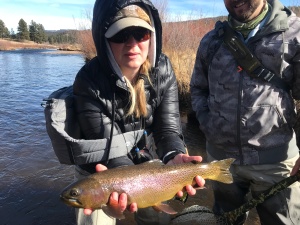
Nice winter fish for this sweet lady
I don’t get it. Usually when I hear something like that I can find some merit, or reasoning. I am still stumped many months after hearing this, and have shared this story with many in hopes someone could enlighten me. Not being a jerk here, but honestly trying to figure out what I am missing, because I just might learn something. Shoot me a note with any theories. You can’t ask a stupid question here, or give a stupid response, it’s all about learning.
The Eagle River has some shelf ice up high, and downstream you’ll find smaller amounts. The lower river has been checking in at about 38 degrees at ten in the morning, and warms up to about 41 degree on full sun days. Midges are coming off, and I (and the fish) are already beginning to look for Blue-Winged Olives. Not a bad idea to throw a pink San Juan, Black Soft Hackled PT, and a Buttcrack Baetis in that order, if you’re so inclined. Other combinations will work equally as well as long as depth and speed are dialed in. Go low and slow.
The latest book (Hidden in Plain View) is still doing well. Thanks again everyone.
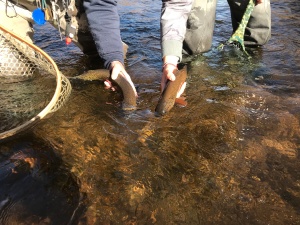
Sweet release times two….
Fear No Water!
Duane
Hidy Ho Good Neighbors!
Folks insinuate all of the time that as a fly fishing guide, all I do is stand in the water and bark orders. Couldn’t be further from the truth. I often will count my steps on my phone app, and I’m regularly in the six mile range when I guide six continuous hours or more. More often than that, by 9am in the morning, I’ve already sweated through my hat. Not all days are like that but those of us that wade guide hustle a bit more than folks think.
Guiding is a lifestyle and I wouldn’t have it any other way. I enjoy zipping back and forth between clients, landing fish, teaching, and yes, even untangling leader and tippet explosions. I enjoy the outdoors, sights and sounds, driving to the river with expectations, tying bugs the night before, and battling Mother Nature everyday anew. I enjoy the grind, dipping my hat in the drink because it’s so damn hot, dodging thunder storms, sunscreen burning my eyes, freezing my finger tips, the physical exertion, and the challenge. I like sitting on my tailgate behind the fly shop, guzzling a well-earned beer and smoking my pipe at the end of a long day on the river.
Couple years ago in July, and I remember it as if it were yesterday, I began the day with 3 clients from Ohio. We fished near Wolcott on the Eagle River for about six hours, and had a pretty successful outing with many fish hitting the bottom of the net. On my way back to the shop, toting my clients, I get a call from one of our managers. “Hey D, this is so-and-so, got one of your regulars in the shop, he just hit town unexpectantly and wants to know if you can give him four hours this afternoon on the river.” “Ah, sure” I reply, trying to not get my clients involved in the conversation. “Good, ok”, says my manager and he squeezes in the next words without taking a breath, “Can you hoof it?” “He has late dinner plans for tonight.” “I’m about twenty minutes out”, I say.
I love doing “doubles”, but I’m rarely prepared for that call. If I know they’re booked, it’s much easier to transition from trip to trip than finding out last minute. I had plans, like a nap, maybe go fish a bit, or hang out with my colleagues. No worries, I’ll make this happen, but I have a routine that I like to follow. I like to re-rig all of my rigs with fresh bugs and tippet the night before my next day trip. I like to go through a physical and mental checklist, I hate to be hurried prior to a trip, and I like to be at least an hour early before a guide trip. In this circumstance, I had none of those. Not only am I a creature of habit, but I’m a bit superstitious…..I have learned to not let this kind of stuff bump me off my game.
I dropped my clients off at the municipal lot down the street from the shop. Knowing my client was waiting for me at the shop, I decided to take a five minute break right where I was, and try to find something to eat and drink. My cooler revealed I had 4 waters left, one warm beer,and I was out of snacks. That’s the other thing I was going to do, hit the supermarket for drinks and goodies. Oh well, I needed to save the water for sure, but I’m thirsty as heck, “Guess I’ll pound the warm beer”, I thought out loud. I dropped the tailgate and took a good guzzle of warm suds. Just then it dawned on me, yesterday I bought a bagel at the supermarket before my trip, “Where did I leave that?”. I started rummaging through the backseat looking for that blueberry bagel. I reached under the front seat and found pay dirt. Yes, warm beer and a blueberry bagel for lunch! One of the best lunches I ever had.
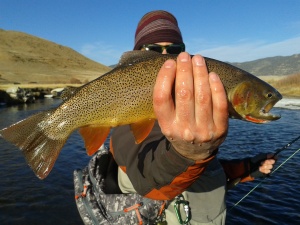
Winter spoils
I went out with my client that afternoon and we threw dry flies for about four hours. Can’t get much better than that. No, guiding is not the toughest job in the world, but it does have its challenges. Now when someone asks me how my day went, I usually reply, “I was outstanding in the river.” Ya, I know, guide humor ain’t much, but it’s better than a beer and a bagel.
The Eagle River has been fishing well this winter. Little shelf ice, clear water and active fish has made for a good start to 2018. We desperately need snow though, so if you live within 1000 miles of us, send some our way.
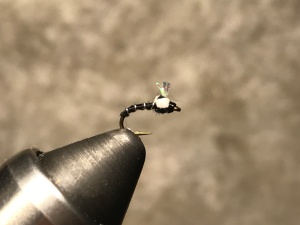
Butt Crack Midge for winter.
Humbled to say the book is doing well. Thanks to all of you who has purchased a copy of Hidden in Plain View. Review it on Amazon if you’re so inclined, or shoot me a note letting me know your thoughts. Thanks again!
Fear No Water!!!

Thank you!
Hidy Ho Good Neighbors,
I’ve heard it said, “If you’re the smartest guy in the room, you’re in the wrong room”. I certainly not only subscribe to that notion, but find it easy to not be the smartest guy in the room.
Recently, I had the opportunity to be a featured author at a book signing at the Blue Quill Angler in Evergreen Colorado. This was not your normal book signing, not when you’re elbow to elbow with John Gierach, Pat Dorsey, Ed Engle, Landon Mayer, Marty Bartholomew, Steve Schweitzer, David McElwain, and Terry Grosz. Nope, this was something special for me and I was humbled and excited to be counted in the fold.
There are many ways to learn new skills, tactics, techniques, or perceptions about any endeavor. Most folks learn

Wasn’t the smartest in the room this day….Lightening and hail in the high country and it’s me and my 6’5″ client…..
best by seeing or doing, while the rest learn by reading or study, and it’s always easier to learn from someone that already knows what you want to learn (think back to 7th grade Spanish class). Therefore, when I’m in the situation where I am surrounded by tons of knowledge, I keep my mouth shut and listen, listen, listen. I still have so much to learn about fly fishing.
I’ve been guiding a long time, before that, I taught school for 22 years, and I feel as if I have a pretty good handle on how to break things down, present them in bite-sized pieces and feed them to hungry learners. I had great mentors that taught me the “teaching ropes” and that hastened the process. Still, after 22 years, I wasn’t the smartest in the room, but was still the hungriest. Hungry to learn, learning by listening and watching, followed by a healthy dose of “go do”.
I consider myself a life-long learner, and I realize I have a long way to go when it comes to mastering what I do, but that doesn’t stop the journey. This year, I’ll be presenting to folks all across this country, a brand new fly fishing presentation. I try to create a new one each year, to keep things fresh for me and my audiences. Do I know everything? Not in the least, but I do know this, the more I teach, the more I learn. More often than not, I come away from an evening presentation with more questions bouncing around in my head. Stuff I can only answer by getting on the river.
During the slower months of winter, when I guide sparingly, I often look to put a bit of time into fishing. Funny thing is, I never go just to catch fish. I’m always working on or testing something. I may be testing a rig wrinkle, bug stage modification, a specific drift mechanic, or a modified piece of equipment, but I always fish with a purpose other than trying to just put fish in the net. Often, I am fishing with folks that are nailing fish, but I keep testing, pushing the envelope, and trying to learn, while watching fish after fish hit the bottoms of their nets. It takes discipline and a pile of hard-headed stubbornness to not just blow-off what I’m doing and simply fish, but I remain steadfast in my mission.
I’m always looking for a new perspective, or a subject that receives too little attention, maybe a newly recognized (to me) cause and effect, or something that I consider obscure by the standards that I guide and fish to. Ultimately, I try to pass what I learn onto the folks that I guide, that read my books, or that see my presentations. It’s worth it.
This years’ presentation is titled: The Dance, Landing Trout on a Fly Rod. I’ve been thinking about this presentation for years, because everyone talks about everything from the cast to the drift, and the set, even how to take photos, but actual discussion of fish landing techniques and rod physics is rarely broached. Gonna’ change that. I truly hope folks will like it.

The Dance
Hidden in Plain View is doing great. Thanks to those of you that have purchased the book. Proud to say it’s still in the top 10 of new fishing releases through Amazon after 3 weeks in. Pretty humbling for sure.
So, you see, that extra work, the little touch of stubbornness (depends on whom you talk to), and the ability to listen while realizing you’re not the smartest in the room, is worth it in the long run. Hopefully, at the next show, event, or club gathering, you and I get a chance to talk, I always welcome the opportunity to learn new things.
Fear No Water!
ps. the new speaking schedule is up.
Pss. There’s still time to purchase a copy of the book before Christmas (Amazon/Barnes and Noble)

Still time!
Hidy Ho Good Neighbors!
“I probably would’ve set on that”. “I didn’t even see it move”, he replied. I said automatically, “Yea, we need to keep working on the take recognition”. All too often, I watch fish after fish eat our offerings and nothing is done on the business side of the fly rod. Doesn’t matter, it could be an eat on the swing, lift, drift or surface, and nothing happens.
I’m beyond getting frustrated with clients when they don’t recognize a fish eating their offerings; I try instead, to use it as a teaching tool. Breaking down the missed opportunity right after the fact, seems to more completely reinforce the need and timing of something that should have been set upon, than beating them over the head with it. And, like magic, once they relax and hook a few, they begin to recognize more eats and set more quickly.

The more you set correctly, the more solid hook-ups you create….
I think most folks, even my experienced clients, that miss fish are usually preoccupied with working on another skill, and/or are overwhelmed with tougher drifts. The tougher the drift, the more mending, and the more difficult it becomes to babysit the drift. Many times clients miss takes because they are watching their hands and the fly line to ensure a good drift, and lose focus on the indicator, indicator fly (dry-dropper), or the dry fly on the surface. Sometimes, when working on advanced skills, such as, pause and go mending, folks again lose focus on the take, and miss fish. It’s easy to do.
So, how do you fix this? What do you do if you are continually missing fish? Simplify. In this case, simplification takes place in two ways: doing less while perfecting more. Perfect the ability to mend without taking your eyes off of the indicator, sighter leader, dry fly, or indicator fly. As you become more proficient at having both hands work as one, you will begin to do less, work less, and simplify the drift. So, the first simplification is teaching the hands to work together, next skill is to stop out-casting your coverage.
Out-casting your coverage begins when you have too much line out for your skill level. I believe in healthy management loops below the reel, and large slack mends if your skill level calls for it, but once you feel as if you are continually mending in your drift and can’t keep up, be honest and realize you’ve hit your limit. No shame in that, just keep working to increase your coverage. Again, simplify.

Don’t out-kick your drift ability coverage.
This sounds basic, but many folks don’t really know how to set once they do recognize an eat. All sets are not created equal. Nymph drift sets are a low sweeping motion downstream over the water. You must set the distance required to actually straighten out the line to pierce the lip. Many folks set quickly enough, but “short-set” and never straighten the line. The dry fly and dry-dropper set are usually downstream over the downstream shoulder. Much less force is applied than the nymph set because there’s not as much drag on the rig, and too much force can result in a snap-off. Be careful to set “against the fish” when setting on a dry fly, striving to set from the fish’s head to its tail. Streamer sets are completed by using your stripping hand to set the hook by pulling the management loop back toward your butt pants pocket as if you’re completing a large streamer strip. Again, these are simple sets, but require a bit of practice.
A few other tidbits: strive to learn to “vicinity set”. Try to set on any fish flash within the vicinity of your flies. For example: if you’re running a nymph rig 8 feet from indicator to your last fly, set on any fish flash within four feet of the indicator. More often than not, if you set on a fish flash within the vicinity of your drift, you’ll move a fish. If you are sight fishing, and can see the fish, learn to set on fish movement. If the fish are feeding side-to-side, set when they swing to one side and stop, before returning to their position. Same thing if fish are porpoising, set when they stop, before they go back down to their original position.
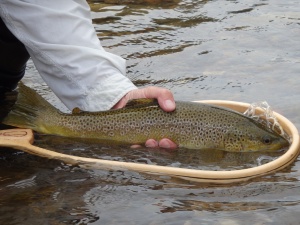
The reward after a fine battle.

There’s much more to cover here, and I go into great detail in my next book, Hidden in Plain View. The book is now in pre-sales, I think you’ll like it. It was recently the number one new fishing book, so I’m pretty pleased with that. Amazon, Barnes and Noble are offering presale discounts for a short time.
Simplify, simplify, simplify, and Fear No Water!
Duane



